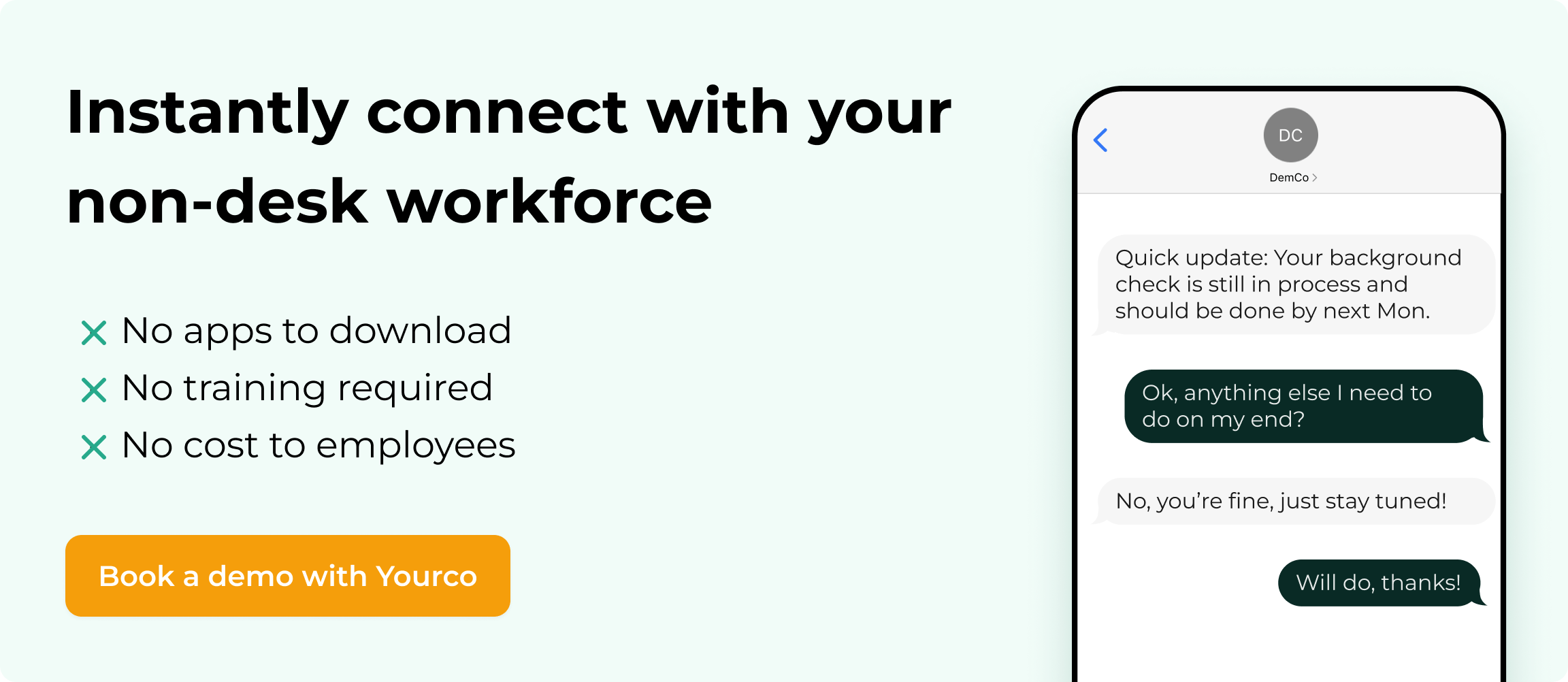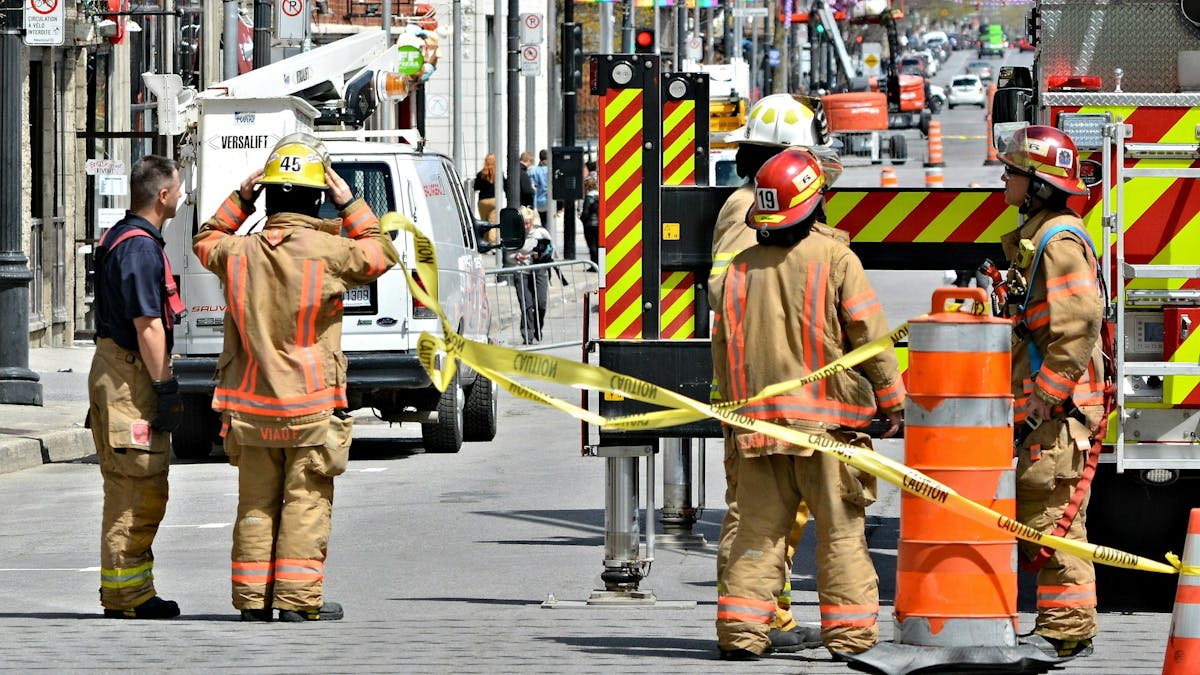Stay Cool on the Job: Heat Safety Tips


Over 3,500 workers suffer heat-related injuries annually in the U.S., with dozens of preventable deaths, according to OSHA statistics. For non-desk workers without traditional communication channels, the risk increases significantly. Proper heat safety measures protect workers and benefit companies through reduced sick days and stronger retention.
With OSHA increasingly enforcing heat standards and several states enacting specific regulations, employers face liability for inadequate protection. Effective communication tools that reach workers wherever they are have become necessary for implementing sound heat safety measures, especially for teams without email access or computer workstations.
Understanding Heat-Related Illnesses
Recognizing heat-related conditions and responding appropriately are foundational skills for workplace safety. The spectrum ranges from uncomfortable to life-threatening, with each condition requiring specific interventions.
Defining Heat-Related Illnesses
The human body maintains a narrow temperature range (around 98.6°F) through sweating and blood vessel dilation. When these mechanisms become overwhelmed in hot environments, a cascade of increasingly serious conditions can develop:
- Heat Rash: Skin irritation from excessive sweating and clogged pores. While uncomfortable, it's mostly benign but signals poor heat tolerance.
- Heat Cramps: Painful muscle spasms resulting from electrolyte depletion after heavy sweating, typically affecting those working in hot environments.
- Heat Syncope: Fainting episodes caused by dehydration, lack of acclimatization, and blood vessel dilation, particularly when standing for long periods.
- Heat Exhaustion: The body's serious warning that its cooling systems are failing. The CDC describes this as excessive sweating, weakness, cold/pale/clammy skin, fast/weak pulse, nausea, and headache.
- Rhabdomyolysis: A dangerous condition where overheated, damaged muscles break down, releasing proteins into the bloodstream that can cause kidney damage. OSHA has documented this condition specifically in new workers not acclimatized to heat.
- Heat Stroke: A life-threatening emergency where the body temperature rises above 103°F. The sweating mechanism fails and the body cannot cool down, leading to potential permanent disability or death within minutes if untreated.
Signs and Symptoms
Heat Rash
- Early: Red clusters of pimples/blisters on neck, chest, groin, under breasts, elbow creases
- Advanced: Secondary infection, spreading rash, increasing discomfort
Heat Cramps
- Early: Muscle twitching, painful spasms usually in legs, arms, or abdomen
- Advanced: Severe cramping, inability to continue working, symptoms of heat exhaustion
Heat Syncope
- Early: Lightheadedness, dizziness upon standing
- Advanced: Brief loss of consciousness, falling, possible injury from falling
Heat Exhaustion
- Early: Heavy sweating, fatigue, thirst, headache, nausea, irritability
- Advanced: Cool/moist skin, rapid/weak pulse, low blood pressure, dizziness, weakness, muscle cramps, nausea/vomiting
Rhabdomyolysis
- Early: Muscle cramps/pain, abnormally dark urine, weakness
- Advanced: Kidney damage, stopped urine production, irregular heartbeat
Heat Stroke
- Early: Confusion, slurred speech, hot/dry skin or heavy sweating, very high body temperature (103°F+)
- Advanced: Seizures, unconsciousness, death (medical emergency requiring immediate intervention)
Industries at Risk
Certain work environments pose significantly higher heat-related dangers due to environmental conditions, physical demands, and limited access to cooling resources. Recognizing these risks helps implement effective heat safety tips in the workplace.
Outdoor Work Environments
Construction workers face some of the highest risks.According to the U.S. Environmental Protection Agency (EPA), from 1992 to 2022, 986 workers across all industries in the United States died from exposure to heat—an average of 34 deaths per year.
Notably, 334 of those fatalities occurred in the construction sector alone, making up about 34% of all occupational heat-related deaths. That’s because their work combines direct sun exposure, physical exertion, limited shade options, and often inadequate water access.
Agricultural workers fare little better, with CDC research showing that farmworkers die from heat stroke at a rate 20 times greater than U.S. workers overall. Long hours in direct sunlight, limited rest periods, and often piece-rate payment incentives that discourage breaks contribute to this grim statistic.
Other high-risk outdoor occupations include:
- Landscaping and groundskeeping
- Delivery services (particularly non-air-conditioned vehicles)
- Utility workers (especially during emergency restoration periods)
- Road construction crews (working over heat-absorbing asphalt)
Indoor Heat-Prone Environments
Contrary to what many believe, indoor workers often face greater heat dangers than their outdoor counterparts. Without natural airflow, heat generated by equipment and processes gets trapped, creating hazardous conditions.
Commercial kitchens exemplify this risk, with temperatures regularly exceeding 100°F near cooking equipment. A study on hospitality kitchen workers in Ethiopia found a high prevalence of heat-stress-related symptoms, including dizziness and fainting.
Other high-risk indoor settings include:
- Manufacturing facilities with heat-generating processes
- Laundry operations with steam and dryer heat
- Non-climate-controlled warehouses, particularly upper levels
- Foundries and metal processing facilities
- Glass production plants
Moreover, the regulatory gap compounds these dangers. While some states have outdoor heat standards, fewer have explicit indoor heat regulations, even though indoor heat can reach more dangerous levels due to humidity, poor ventilation, and equipment heat generation.
Preventative Heat Safety Tips for the Workplace
Effective heat safety requires both system-level planning and individual behavior change. Companies that implement comprehensive preventative strategies and adhere to essential safety rules don't just reduce incidents; they see measurable improvements in productivity, retention, and regulatory compliance.
Planning and Risk Assessment
Effective heat safety begins with thorough risk assessment by evaluating these four key factors:
- Environmental conditions (temperature, humidity, air movement, radiant heat)
- Work requirements (exertion level, duration, required PPE)
- Worker characteristics (acclimatization status, health conditions)
- Workplace controls (availability of shade, water, rest areas)
The assessment should produce a written Heat Illness Prevention Plan (HIPP) tailored to your specific workplace. Important components include:
- Daily monitoring protocols using heat index apps or WBGT meters
- Trigger points for implementing additional controls
- Site-specific hazards and control measures
- Emergency response procedures
For maximum effectiveness, plans should account for seasonal changes and regional climate patterns rather than reacting to single-day forecasts.
Acclimatization
Physiological adaptation to heat is perhaps the most powerful protective mechanism available, yet OSHA investigations found that 71% of heat-related fatalities occurred during workers' first week on the job—before acclimatization could develop.
The acclimatization process gradually increases the body's tolerance through:
- Increased sweat production
- Earlier onset of sweating
- Reduced salt concentration in sweat
- Expanded blood volume
- Improved cardiovascular efficiency
Consider this gradual exposure schedule:
- New workers: Start with 20% of normal workload, increasing by no more than 20% daily
- Returning workers (after 1+ week away): Start with 50% on day one, 60% on day two, 80% on day three, 100% on day four
During acclimatization, supervisors should:
- Schedule work during cooler hours
- Assign a buddy to monitor for symptoms
- Increase water and rest breaks
- Watch for signs of heat intolerance
Even fully acclimatized workers need continued monitoring, as acclimatization benefits can diminish after just a few days away from heat exposure.
Hydration and Breaks
Specific hydration protocols save lives. OSHA guidelines recommend workers consume about one cup (8 oz) of water every 15-20 minutes when working in heat—not waiting until thirsty, as thirst signals dehydration has already begun.
For physically demanding work in high heat:
- Workers need up to 1 quart (32 oz) of water per hour
- Water should be cool (50-60°F) but not cold
- For extended shifts (>3-4 hours of sweating), electrolyte replacement becomes important
Rest break frequency should scale with conditions:
- At 82-84°F WBGT: 10 minutes rest per hour
- At 85-87°F WBGT: 20 minutes rest per hour
- At 88-89°F WBGT: 30 minutes rest per hour
- At 90°F+ WBGT: 40 minutes rest per hour
Rest areas must provide genuine relief through shade, ventilation, or air conditioning, with temperatures at least 10°F cooler than work areas.
Engineering and Administrative Controls
Engineering controls physically modify the work environment to reduce heat exposure, while administrative controls change work practices and policies.
Effective Engineering Controls:
- Ventilation systems that provide spot cooling near hot equipment
- Reflective shields around radiant heat sources
- Outdoor shade structures (portable canopies, shade cloths)
- Cooling stations with misting fans or air conditioning
- Mechanical aids that reduce physical exertion
Practical Administrative Controls:
- Shift heavy work to cooler morning or evening hours
- Mandate rest breaks more frequently during extreme temperatures
- Rotate staff between high and low-heat tasks to limit exposure
- Schedule maintenance of heat-producing equipment during off-peak heat seasons
- Adjust shift durations based on forecasted heat index levels
Training and Education on Heat Safety Tips in the Workplace
Comprehensive training transforms heat safety from policy to practice. OSHA recommends training for all employees before hot weather begins, with role-specific content for workers, supervisors, and first aid providers.
Essential training components include:
- Heat illness progression and symptoms
- Personal and environmental risk factors
- Site-specific preventative measures
- Hydration requirements and water access
- Reporting procedures for symptoms
- Emergency response protocols
- Acclimatization requirements
Training effectiveness depends on the delivery method. For diverse workforces, this means:
- Multiple language options
- Visual/pictorial formats for varying literacy levels
- Hands-on demonstrations of monitoring equipment
- Practice scenarios for emergency response
- Brief, frequent refreshers rather than one annual session
By focusing on overcoming language barriers, employers can ensure that safety training is effective for all employees. Implementing practical communication tips can enhance training effectiveness, ensuring that the message reaches all employees regardless of background. Effective non-desk employee onboarding is important to ensure all workers are prepared for heat-related challenges.
In addition, training documentation becomes significant for regulatory compliance and continuous improvement. Digital tracking systems that record completion dates and comprehension verification provide strong protection against liability.
Monitoring and Supervision
Even with comprehensive preventative measures, ongoing monitoring is essential as conditions change throughout the workday. Effective monitoring combines technological tools with human supervision to ensure heat safety in the workplace.
Utilizing Technology
Environmental monitoring technology has advanced significantly, making sophisticated heat safety tools accessible for businesses of all sizes. Emergency notification systems such as SMS platforms transform monitoring into action through:
- Pushing real-time heat alerts when conditions change
- Sending automated hydration reminders on predetermined schedules
- Facilitating quick reporting of hazardous conditions or symptoms
- Confirming worker receipt of safety messages
- Distributing location-specific guidance during heat waves
SMS-based communication systems, a type of employee alert system, transform monitoring into action through these features.
For implementation, companies should establish clear alert thresholds, assign responsibility for monitoring, and create escalation procedures when dangerous conditions are detected.
Supervisor Roles
Frontline supervisors serve as the human element in heat safety programs. Their responsibilities must be clearly defined and supported with proper training and resources.
Essential supervisor duties include:
- Monitoring environmental conditions throughout the shift
- Ensuring water supplies remain clean, cool, and accessible
- Enforcing mandatory rest breaks during high heat
- Conducting regular visual checks of workers for symptoms
- Adjusting work assignments based on conditions
- Implementing emergency procedures when needed
The buddy system provides an additional safety layer, pairing workers to watch for heat symptoms in each other. This approach catches early symptoms that self-monitoring might miss.
Supervisors also shape workplace safety culture. Workers are far more likely to report symptoms early when supervisors:
- Regularly discuss heat safety during toolbox talks
- Model proper hydration and rest behaviors
- Recognize and praise safe practices
- Respond supportively when symptoms are reported
- Never penalize productivity reductions due to heat protocols
Addressing Personal Risk Factors
Individual differences significantly impact heat tolerance. While environmental controls protect everyone, addressing personal risk factors provides an additional safety layer for vulnerable workers in the workplace.
Identifying Vulnerable Individuals
Several personal factors increase heat sensitivity:
Age: Both older workers (55+) and very young workers (under 25) show higher heat illness rates. CDC data indicates older workers have decreased thirst response and sweat gland efficiency, while younger workers often lack experience recognizing symptoms.
Medical Conditions: Several common health issues increase heat vulnerability:
- Heart disease (reduces cardiovascular capacity to respond to heat)
- Diabetes (affects hydration status and blood vessel function)
- Obesity (reduces heat dissipation, increases metabolic heat)
- Hypertension (especially with certain medications)
Medications: Many common prescriptions affect heat tolerance, including:
- Diuretics ("water pills")
- Antihistamines
- Certain blood pressure medications
- Psychiatric medications
- Some cold and allergy products
Previous Heat Illness: Research indicates that individuals who have previously experienced heat illness are more vulnerable to recurrence, often showing symptoms at lower temperatures than their peers.
Identifying these factors requires sensitivity to privacy concerns. Best practices include:
- Confidential self-identification opportunities
- Voluntary medical disclosure forms
- General education about risk factors for self-assessment
- Optional personalized monitoring for those who disclose risk factors
When risks are identified, reasonable accommodations might include:
- More frequent rest breaks
- Assignment to cooler work areas
- Enhanced monitoring through buddy systems
- Modified work schedules during extreme heat
- Closer supervision during acclimatization
Implementing incentive compensation strategies can encourage workers to adhere to safety protocols and report heat-related symptoms promptly.
Emergency Readiness and Response
Despite best prevention efforts, heat emergencies can occur with little warning. The difference between life and death often comes down to minutes, making emergency preparedness essential in the workplace.
Developing a Response Plan
Every worksite needs a heat emergency action plan with these core elements:
Clear Procedures: The emergency response flowchart should be simple enough to follow under stress.
Assigned Responsibilities: Specific individuals must be designated for:
- Calling emergency services
- Providing first aid until help arrives
- Meeting and directing emergency responders
- Communicating with other workers and management
- Documenting the incident
Cooling Resources: Immediate cooling is the main intervention for serious heat illness. Plans must specify:
- Location of cooling equipment and supplies
- Ice pack/cold water immersion protocols
- Use of fans or air-conditioned spaces
- Removal of excess clothing
- Appropriate cold water application techniques
Communication Protocols: Multi-channel notification systems ensure rapid response. SMS platforms provide particular advantages through:
- Location-specific emergency alerts
- Pre-programmed emergency procedures sent automatically
- Two-way verification that help is on the way
- Real-time updates to all affected parties
- GPS location sharing to guide emergency responders
First aid measures vary by condition severity:
For Heat Exhaustion:
- Move to cool area (shade or air conditioning)
- Loosen clothing
- Apply cool, wet cloths or ice packs to head, face, neck
- Sip water slowly if conscious and not nauseated
- Monitor for improvement or deterioration
For Heat Stroke (Medical Emergency):
- Call 911 immediately
- Move to cool area
- Remove outer clothing
- Cool rapidly using ice bath, cold water spray, or ice packs at neck, armpits, groin
- Do not give fluids if unconscious
- Monitor vital signs until emergency services arrive
Compliance with Regulations
The regulatory landscape for heat safety continues to evolve, with both established standards and emerging requirements. Staying compliant protects both workers and companies from preventable consequences.
Understanding Legal Requirements
While the federal OSHA has yet to implement a specific heat standard, it actively enforces heat safety through its General Duty Clause, which requires employers to provide workplaces free from recognized hazards.
Several states have enacted their own heat standards:
California's Heat Illness Prevention Standard (Title 8, Section 3395) requires:
- Fresh, cool water (1 quart per worker per hour)
- Shade when temperatures exceed 80°F
- Rest breaks for preventative cooling
- Acclimatization procedures
- Training for all employees and supervisors
- Written prevention procedures
Washington, Oregon, Minnesota, and Colorado have implemented similar standards with specific thresholds and requirements.
Employers face significant enforcement consequences for non-compliance. OSHA penalties now reach $15,625 per serious violation, with repeat or willful violations up to $156,259. Multiple employers have faced six-figure fines following heat-related fatalities.
Documentation becomes necessary for demonstrating compliance. Digital communication systems provide particular advantages by automatically recording:
- Heat safety message delivery and receipt
- Training completion verification
- Rest break compliance
- Hydration reminder acknowledgments
- Work modification notices during high heat
Companies should designate specific individuals responsible for regulatory tracking, as proposed federal standards and additional state requirements continue to emerge.
Continuous Improvement and Resource Utilization
Heat safety programs should evolve based on experience, incident data, and changing conditions. This requires both tapping external knowledge and creating internal feedback mechanisms.
Utilizing External Resources
Several authoritative resources provide continually updated heat safety guidance:
- OSHA's Heat Illness Prevention Campaign offers comprehensive resources including training materials, posters in multiple languages, and industry-specific guidance.
- NIOSH's Heat Stress Topic Page provides detailed technical information, research updates, and specialized resources for different work settings.
- Industry associations often develop sector-specific guidance addressing unique challenges. The Construction Industry Safety Coalition and AgriSafe Network offer particularly robust resources.
SMS platforms maximize resource utilization by distributing links directly to workers' phones, enabling immediate access to:
- Training videos and infographics
- Toolbox talk materials
- Region-specific weather alerts
- Updated safety protocols
- Interactive heat safety tools
Developing relationships with occupational health providers who understand heat-related illnesses creates another valuable resource. These specialists can help customize prevention programs, review incident data, and provide advanced training.
Encouraging Feedback and Adaptation
Creating effective feedback loops transforms heat safety from a top-down mandate to a collaborative effort.
Anonymous Reporting Systems allow workers to identify hazards or suggest improvements without fear of reprisal.
After-Action Reviews following every heat-related incident (even minor ones) help identify system gaps. Key questions include:
- What preventative measures were in place?
- Were early warning signs recognized?
- How quickly was the response initiated?
- What could improve future prevention/response?
Regular Safety Committee Discussions should include heat topics year-round, not just during summer months. Representation from different departments ensures a comprehensive perspective.
Data Collection Through Surveys provides quantitative improvement metrics. SMS-based polling features offer particular advantages:
- Real-time feedback during/after high heat events
- Higher response rates than paper surveys
- Ability to track trends over time
- Immediate identification of problem areas
- Comparison across different worksites
Companies with mature heat safety programs typically review and revise their protocols at least annually, incorporating feedback, incident data, and regulatory updates into continuously improving protection.
The Value of Communication Tools for Heat Safety
Effective workplace heat safety programs thrive on team accountability and proactive communication. When workers actively look out for each other and stay informed, the risk of heat-related incidents drops significantly. For non-desk employees in physically demanding industries, staying connected isn't just convenient—it's a matter of safety.
Yourco’s SMS-based employee app is built for exactly this kind of environment. It ensures instant delivery of critical alerts—heat warnings, hydration reminders, and emergency procedures—so that every worker, no matter their location or device, stays informed and protected. Supervisors can send personalized messages to specific crews based on job site conditions or exposure levels, while workers can easily report unsafe temperatures, symptoms of heat stress, or equipment issues with a simple reply.
Unlike complex systems that require apps or training, Yourco’s SMS approach works on any basic phone, making it accessible to all employees without introducing friction. Multilingual safety alerts remove language barriers that might otherwise delay response or reduce clarity during urgent situations.
But Yourco goes beyond communication. It delivers frontline intelligence that helps corporate offices monitor safety performance and compliance at each location. Every message, report, and alert is logged and analyzed, providing visibility into how each site is engaging with safety protocols, responding to incidents, and maintaining regulatory standards. With this data, HR, safety, and operations leaders can identify gaps, monitor emerging risks, and proactively manage compliance across multiple job sites.
Yourco improves the effectiveness of heat safety programs, supports compliance efforts, and creates a safer work environment from the ground up—all without adding complexity.
Try Yourco for free today or schedule a demo to see how the right workplace communication solution can transform your safety strategy.



